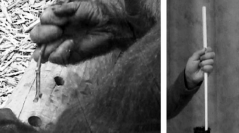

 Comptes Rendus Palevol
5 (3-4) - Pages 597-602
Comptes Rendus Palevol
5 (3-4) - Pages 597-602The term ‘precision’, defined as the ability to oppose the tips of thumb and index, is generally attributed to humans, tool use and associated with morphological criteria. Identified in fossils, those criteria are used to assert that they belong to the genus Homo and they manipulated tools. Observations of 67 Catarrhines and one Platyrrhine allowed us to quantify surfaces of fingers used during simple tasks of grasping both small and large objects, as well as during complex tasks of proto-tool and tool use. We concluded that precision handling is not peculiar to humans and that it is not systematically linked to tool use. Moreover, these results allowed us to discuss morphological traits used till now to deduce precision, tool use and hence the human character of a fossil.
Grasping, Tool, Precision, Cebus, Catarrhines